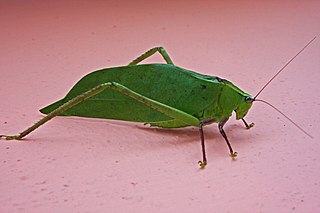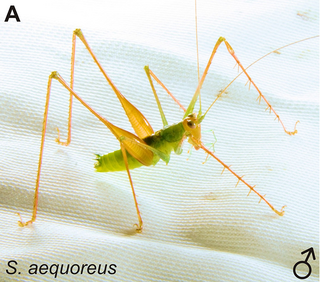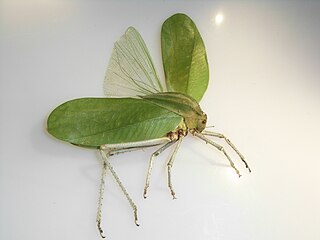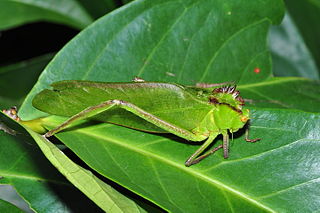
Insects in the family Tettigoniidae are commonly called katydids, or bush crickets. They have previously been known as "long-horned grasshoppers". More than 8,000 species are known. Part of the suborder Ensifera, the Tettigoniidae are the only extant (living) family in the superfamily Tettigonioidea.

Ensifera is a suborder of insects that includes the various types of crickets and their allies including: true crickets, camel crickets, bush crickets or katydids, grigs, weta and Cooloola monsters. This and the suborder Caelifera make up the order Orthoptera. Ensifera is believed to be a more ancient group than Caelifera, with its origins in the Carboniferous period, the split having occurred at the end of the Permian period. Unlike the Caelifera, the Ensifera contain numerous members that are partially carnivorous, feeding on other insects, as well as plants.

Saga pedo is a species of wingless bush cricket from the southern half of Europe and western and central Asia. This brown or green bush cricket typically has a total length, from the head to the tip of the ovipositor, of up to 10.5 cm (4.1 in), but exceptionally it may reach 12 cm (4.7 in), which makes it one of the largest European insects and one of the world's largest Orthoptera. The head-and-body alone typically is 5–7 cm (2.0–2.8 in) long in adults, but may reach up to 7.8 cm (3.1 in).

Microcentrum is a genus of phaneropterid bushcrickets, sometimes known as "angle-wing katydids" and found in the Americas.

Taeniopoda eques, the western horse lubber grasshopper, is a relatively large grasshopper species of the family Romaleidae found in arid and semi-arid parts of southwestern United States to central and southwestern Mexico. Most populations are identifiable by their shiny black bodies with contrasting yellow markings, but some adults are mostly yellowish, orangish or greenish. The species is unique in using its black coloration to thermoregulate and in being chemically defended. The aposematic coloration warns vertebrate predators of its unpalatability and allows the grasshopper to roost conspicuously upon shrubs.
Panoploscelis is a genus of very large insects belonging to the true katydid tribe Eucocconotini, which is a subfamily of the Tettigoniidae. Like the other members of the suborder Ensifera, Panoploscelis are part of the insect order Orthoptera, which also contains crickets, grasshoppers and locusts. Members of this genus are among the largest katydids of the Neotropics.

Mecopodinae are a subfamily of bush crickets found in western South America, sub-Saharan Africa, and Asia. In Asia, the distribution includes India, Indochina, Japan, the Philippines, and Malesia to Papua New Guinea and Australasia, including many Pacific islands.

Kasikasima, also spelt Kassikassima, is a mountain in the Sipaliwini District of Suriname. It is 718 metres (2,356 ft) high.

Agraeciini is a large tribe of bush crickets or katydids in the conehead subfamily, Conocephalinae.

Copiphora is a genus of bush crickets or katydids in the subfamily Copiphorinae (coneheads) from southern Mexico, Central America and South America, with a single doubtful species, C. subulata, from Africa.

Stilpnochlora couloniana is a species of phaneropterine katydid in the family Tettigoniidae, native to southeastern United States, the Bahamas and Cuba. It is known as the giant katydid and it is the largest katydid in the United States, with an average length of 6.6 cm (2.6 in) in adult males and 7.8 cm (3.1 in) in adult females. Individuals from Cuba tend to grow 5–10% larger than those from the United States. They are sometimes kept as pets.

Pterophylla camellifolia, the common true katydid, is a common North American insect in the family Tettigoniidae (katydids). Within the Tettigoniidae, it belongs to the subfamily Pseudophyllinae. Other common names include northern true katydid and rough-winged katydid.

Stilpnochlora is a genus of phaneropterine katydids in the family Tettigoniidae, native to tropical and subtropical parts of the Americas. There are about 15 described species in Stilpnochlora.

Caedicia simplex is a species of bush cricket, native to New Zealand and Australia. Its common name is the common garden katydid.

Tropidacris cristata, the giant red-winged grasshopper, is a widespread species of lubber grasshopper in the family Romaleidae from tropical South and Central America, and Mexico. It is among the largest grasshoppers in the world by length and wingspan, reaching up to 14.5 cm (5.7 in) and 24 cm (9.4 in) respectively. More typical adult lengths are 5.5–7 cm (2.2–2.8 in), average 6.5 cm (2.6 in), in males and 7–12 cm (2.8–4.7 in), average 11 cm (4.3 in), in females. As suggested by the common name, adult T. cristata have conspicuously red wings in flight, although the exact red hue varies. The flightless and gregarious nymphs have aposematic dark-and-yellow stripes and are presumed to be toxic.

Supersonus is a genus of katydids in the order Orthoptera first described in 2014. The genus contains three species which are endemic to the rainforests of South America. Its name is an allusion to the fact that the males, in order to attract the females, produce a very high frequency noise which can reach 150 kHz. This has been considered the highest frequency ultrasonic noise of the animal kingdom. The noise is imperceptible to human hearing, which is only capable of detecting up to 20 kHz.

Panacanthus is a genus of conehead katydids found in forests in northwestern South American and Panama, including the western Amazon, the Chocó and the Magdalena River Valley. The common names spiny-headed katydid, spine-headed katydids, spike-headed katydids, thorny devil katydid, thorny devil bush cricket, and similar variations of the sort, do not apply to a single species or to this genus alone, and multiple species are often called by the same common name.

Titanacris is a genus of large grasshoppers in the subfamily Romaleinae and tribe Tropidacrini. They are found from southeastern Mexico, through Central and South America, ranging south to northernmost Argentina.

Siliquofera is a genus of bush cricket in the subfamily Phyllophorinae that includes only one species, Siliquofera grandis, which is fairly common and widespread in rainforest canopies of New Guinea and nearby smaller islands, and seemingly rare in Australia where only found in the remote Iron Range region. This very well-camouflaged, green and leaf-like bush cricket is one of the world's largest Orthoptera, with adults typically having a length of 10.7–13 cm (4.2–5.1 in) and a wingspan of 25–27 cm (9.8–10.6 in); it can weigh more than 30 g (1.1 oz).

Steirodon is a genus of large phaneropterine katydids in the family Tettigoniidae, native to tropical and subtropical forests in South America, Central America and Mexico.


















